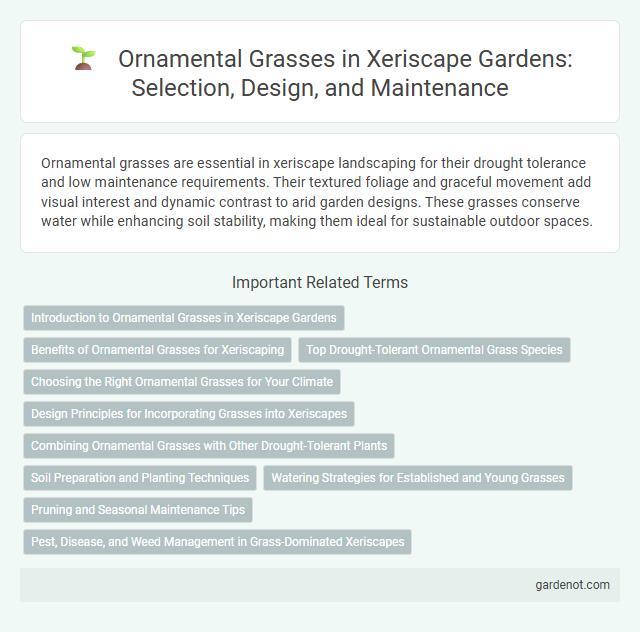Ornamental grasses are essential in xeriscape landscaping for their drought tolerance and low maintenance requirements. Their textured foliage and graceful movement add visual interest and dynamic contrast to arid garden designs. These grasses conserve water while enhancing soil stability, making them ideal for sustainable outdoor spaces.
Introduction to Ornamental Grasses in Xeriscape Gardens
Ornamental grasses in xeriscape gardens offer drought-tolerant, low-maintenance landscaping options that enhance texture and movement. Species such as Blue Fescue (Festuca glauca) and Fountain Grass (Pennisetum alopecuroides) thrive in arid conditions, reducing water usage significantly. Incorporating ornamental grasses supports sustainable garden design by improving soil stability and providing habitat for beneficial insects.
Benefits of Ornamental Grasses for Xeriscaping
Ornamental grasses offer exceptional drought tolerance, reducing water consumption in xeriscape gardens while maintaining year-round aesthetic appeal. Their deep root systems improve soil structure and prevent erosion, enhancing landscape sustainability in arid regions. These grasses provide habitat for beneficial insects and require minimal maintenance, making them ideal for eco-friendly, water-efficient landscaping.
Top Drought-Tolerant Ornamental Grass Species
Top drought-tolerant ornamental grass species include Blue Fescue (Festuca glauca), known for its fine-textured blue-gray foliage and exceptional drought resistance. Mexican Feather Grass (Nassella tenuissima) thrives in dry conditions and adds graceful movement to xeriscaped gardens. Buffalograss (Bouteloua dactyloides) offers low-maintenance ground cover with a high tolerance for heat and limited water availability.
Choosing the Right Ornamental Grasses for Your Climate
Selecting the right ornamental grasses for your climate is crucial to ensure drought tolerance and minimal maintenance in xeriscaping. Warm-season grasses like Muhlenbergia and Pennisetum thrive in hotter, arid regions, while cool-season varieties such as Festuca and Carex perform well in temperate climates with cooler winters. Understanding local climate zones and soil types will help in choosing grasses that improve soil health, conserve water, and enhance landscape aesthetics.
Design Principles for Incorporating Grasses into Xeriscapes
Ornamental grasses enhance xeriscapes by adding texture, movement, and seasonal interest while requiring minimal water. Effective design principles include grouping grasses by water needs, varying heights to create visual layers, and positioning clumping varieties to reduce erosion and improve soil retention. Selecting drought-tolerant species such as Blue Fescue or Feather Reed Grass optimizes water efficiency and supports sustainable landscape aesthetics.
Combining Ornamental Grasses with Other Drought-Tolerant Plants
Combining ornamental grasses such as Feather Reed Grass (Calamagrostis) or Blue Fescue (Festuca glauca) with drought-tolerant plants like lavender, succulents, or agave enhances xeriscape gardens by providing varied textures and colors while conserving water. These plant pairings improve soil health and reduce irrigation needs, promoting sustainable landscaping. Strategic placement ensures optimal sunlight exposure and root space, maximizing drought resistance and aesthetic appeal.
Soil Preparation and Planting Techniques
Ornamental grasses thrive in well-drained, sandy or loamy soil enriched with organic matter for optimal root development in xeriscape gardens. Preparing the soil by loosening it to a depth of 6-8 inches and incorporating compost enhances moisture retention and nutrient availability. Planting techniques include spacing clumps 18 to 24 inches apart and mulching to conserve water and suppress weeds, ensuring healthy establishment and sustainable growth.
Watering Strategies for Established and Young Grasses
Ornamental grasses in xeriscape landscapes benefit from deep, infrequent watering to encourage strong root growth, with established grasses requiring watering every two to three weeks depending on climate and soil type. Young grasses need more frequent, shallow watering--typically twice a week--to maintain adequate moisture for root development during the first growing season. Adjust watering frequency based on seasonal rainfall and soil drainage to optimize water efficiency and promote healthy growth.
Pruning and Seasonal Maintenance Tips
Pruning ornamental grass in xeriscape gardens enhances plant health and maintains aesthetic appeal by removing dead foliage and preventing disease. Seasonal maintenance involves cutting back grasses to a few inches above the ground in late winter or early spring to stimulate new growth and improve air circulation. Regularly dividing and thinning clumps every 2-3 years promotes vigorous growth and prevents overcrowding in drought-tolerant landscapes.
Pest, Disease, and Weed Management in Grass-Dominated Xeriscapes
Ornamental grasses in xeriscape gardens demonstrate strong resilience to common pests such as aphids, spider mites, and grasshoppers, which can be effectively controlled using integrated pest management strategies focused on biological controls and minimal chemical intervention. Disease issues like rust, leaf spot, and fungal infections tend to be less prevalent due to grasses' drought adaptation but require proper air circulation and irrigation practices to prevent outbreaks. Weed management is optimized through the use of mulch layers and selective pre-emergent herbicides to reduce competition, maintaining the health and aesthetic of grass-dominated xeriscapes while conserving water resources.
Ornamental grass Infographic

 gardenot.com
gardenot.com